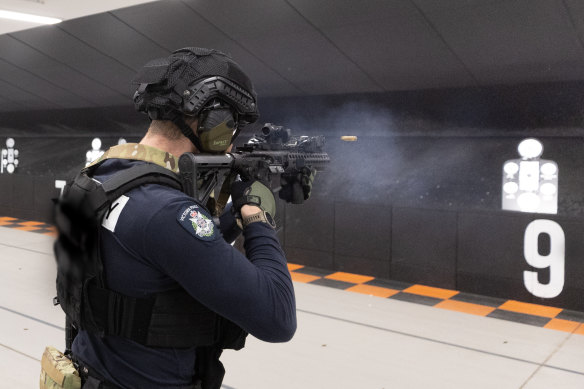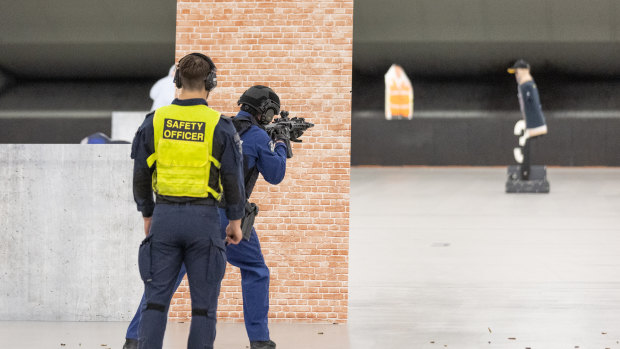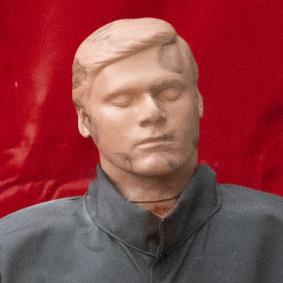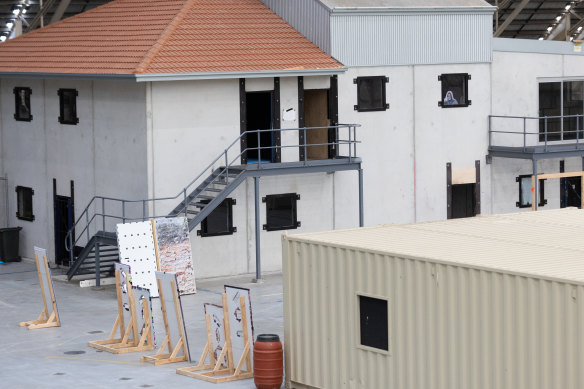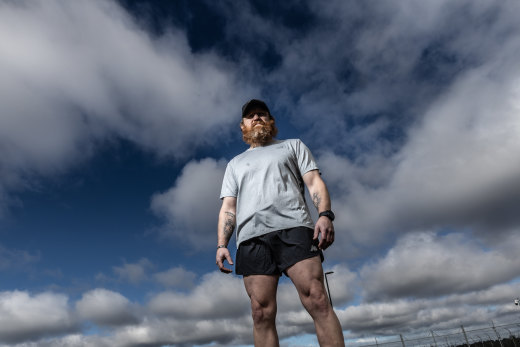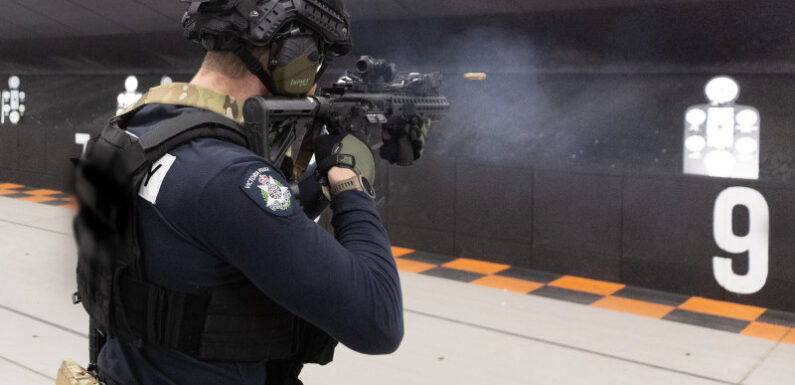
Save articles for later
Add articles to your saved list and come back to them any time.
Politicians love nothing better than to open a brand-new police building because a) it makes them look tough on crime and b) they get to eat all the biscuits at morning tea.
Yet last year, when then police minister Lisa Neville cut the ribbon on the state-of-the-art Special Operations Group (SOG) training facility, there wasn’t a press pack to be seen. That is because it is filled with secret stuff.
Originally planned in 2017, it became operational last year for $59 million and according to Deputy Commissioner Ross Guenther “it is the best of its type in the southern hemisphere”.
From the outside it looks like an industrial complex on the outskirts of Melbourne, with no signage hinting at what is inside. (A word of warning here: if you are a factory burglar, don’t go there. It will end badly.)
As you enter the first massive building, you notice the mess room is spotless. On the wall is the SOG logo, with its motto from Matthew 5:9: “Blessed are the peacemakers, for they shall be called sons of God.”
It is only when you move into the training area that you understand the dimensions. It’s the size of a football ground, with a roof as high as a city building.
Inside the Special Operations Group training facility.Credit: Jason South
We are guided on our tour by “Peter”, a 27-year SOG veteran, who has seen the group evolve from Rambos to high-tech specialists.
“When we started, training was shooting into a dirt mound at Craigieburn,” he says. Now the range manager, he travelled the world to find the best practice to use in the facility.
The SOG was formed in October 1977, when then chief commissioner Mick Miller was called to police minister Pat Dickie’s office to be asked if Victoria was equipped to deal with a terrorist attack. (Dickie, who had only been minister a few months, was on the money, as the following year we had the bombing of Sydney’s Hilton Hotel.)
Off the top of his head, Miller said he needed funding for an elite 15-man Counter-Terrorism Squad, then returned to his office to tell chief inspector Harry “Chippy” Norton — a former British Royal Marines commando — that he was in charge of the CTS.
While mowing the lawns over the weekend Miller rethought the name, believing Counter-Terrorism Squad sounded intimidating, and changed it to the more general Special Operations Group. They quickly became known as the “Sons of God”.
Initial training was brutal runs, bullying, being made to eat cold pies and scoff warm beers while jogging until you threw up before rolling down hills, then lurching back up like a drunken detective leaving the Police Club.
Live shooting practice was in a quarry with a fake building made of old tyres filled with sand. (The original crew, when bored, would sometimes fire at stacked phone books in the office, which made walking from the tea room to your desk an act of faith.)
“Peter” says that as Victoria fell behind, SOG members had to train at army bases or travel to Singapore to prepare.
CIRT training with robots.Credit: Jason South
Not now.
In the new building is a massive gym, six container-type constructions, each providing different raid scenarios, vehicles for mobile intercepts and a two-storey house with quick-replace doors and windows designed to be smashed.
Peter says it is used to practise forced-entry tactics against heavily fortified bikie headquarters and drug houses. Doors can be blasted open, fortifications pulled apart using armoured vehicles and hit with penetrating rounds, upper-storey ladder entries practised and “offenders” shot with paintballs.
Less Lethal Larry, the dummy used in SOG training.Credit: Jason South
Another level is used to practise non-lethal options such as stun guns, riot weapons and beanbag rounds. The damage on practice mannequin “Less Lethal Larry” indicates he has seen better days.
There is also a non-roofed scenario house with elevated viewing platforms, so tactics can be observed. Walls and doors can be moved to suit different operations and set up to replicate a suspect’s house to rehearse a pending raid.
The philosophy is simple: Get it right here, so you don’t get it wrong out there.
The complex is used by the SOG and the Critical Incident Response Team, who in reality are the first to arrive when general police need back-up. “In an evolving incident such as an active armed offender, CIRT is the first response,” says Superintendent David Watt.
In the live shooting range a group of CIRT recruits are training for the unthinkable: multiple armed offenders in a shopping mall.
The SOG scenario training house.Credit: Jason South
Robots dressed as armed offenders and shoppers whizz by, with police having to identify and shoot the baddies. On being hit, the robot doubles over. In the foreground are cutouts of people and behind the robots images of offenders and citizens shoot past, with a fourth line of images popping up from a wall.
Fake cars and trucks for scenario training line a side wall. On the second level is a windowed wall to be smashed in during sniper training.
In a second live fire area, SOG members are practising the El Presidente drill. Using high-powered weapons, they fire two shots each at the images of three offenders. They don’t miss.
In the cushioned live fire house, raids replicate bursting in on armed offenders. Lights can be dimmed to train for night raids, or smoke and tear gas released. A massive exhaust system sucks health-damaging fumes out through the floor.
Dogs are trained to take down a suspect even when wearing heavy muzzles, hence the nickname “the fur missiles”.
The image of the paramilitary SOG and CIRT is simultaneously intimidating and reassuring. We don’t want armed soldiers patrolling our streets, but we do need these specialist police when it comes to life and death.
In January 2017, when James Gargasoulas deliberately drove through the Bourke Street Mall to run down pedestrians, leaving six dead and 27 injured, it was the CIRT that brought it to an end by ramming his vehicle.
Watt says CIRT is a 24-hour patrolling presence that will arrive at any CBD crisis within three minutes and will be the first specialist group to confront active armed offenders.
Meanwhile, at police headquarters a SOG team is always on standby to be picked up by helicopter from the roof to fly anywhere in Victoria.
The less you hear about SOG and CIRT jobs the better, as it means they have been resolved without incident. Watt says the SOG do about four jobs a week and CIRT 22 – around 1400 a year between them.
“The vast majority are resolved without the need to use significant force,” Watt says.
He says CIRT negotiators have peacefully resolved hundreds of potentially violent incidents, many involving people suffering mental health episodes. “Reviewing the bodycam footage, the compassion and dignity shown to people who may just be having a bad day is very impressive.
“It is about talking someone down, not pointing a gun.”
In May 2012, a 44-hour siege in East Keilor involving the armed and dangerous bandit Christopher Dean Binse could have ended badly. The SOG used distraction devices and despite Binse coming out firing, they were able to disable him using non-lethal beanbag shots.
Binse later wrote a letter to the SOG critiquing the operation. You can never have too much feedback.
Crooks don’t like being raided, but if it has to happen many prefer it to be the SOG, as there is less likelihood of something going wrong. As a SOG team leader in the late 1990s, Watt conducted raids during the Underbelly War that left many suspects relieved. “We always made it clear we were the police and it wasn’t armed crooks coming through the door.”
Not that many years ago detectives would conduct their own raids after a short shotgun training course. On Anzac Day 1986, armed robbery detective Mark Wylie – armed with an unfamiliar shotgun and not wearing a ballistic vest – was shot and critically injured during a raid searching for a Russell Street bombing suspect.
The SOG is not just about heavy men with heavy guns. Each generation makes lifelong friends and lifelong commitments.
If Leading Senior Constable Kyle Gemmill didn’t love the SOG, you get the feeling he would have settled as a bush copper years ago.
A 13-year SOG veteran, right now Gemmill looks more like Forrest Gump than an anti-terror cop, for he is on extended leave as he prepares to honour the memory of his colleague and mentor Brendan Warbutton (known to all as KB), who died last year from Ewing sarcoma, a form of bone cancer.
Leading Senior Constable Kyle Gemmill is planning to run seven ultra-marathons (441 kilometres) in seven days to honour the life of his SOG mate and mentor Brendan Warbutton, who died from cancer in November last year.Credit: Jason South
Gemmill is in training, for he plans to run 441 kilometres in seven days – the equivalent of seven ultra-marathons back to back – to raise funds to combat the disease that took his mate.
“I am not a natural runner and have had 12 operations on my legs. I think that because it is such a challenge for me [it] makes it the right way to honour KB.”
He will start from his home town of Narbethong on November 3 and arrive at police headquarters on the anniversary of Warbutton’s death. “We aim to raise $100,000 for research,” he says.
Gemmill has set up a GoFundMe page for donations.
Most Viewed in National
From our partners
Source: Read Full Article
